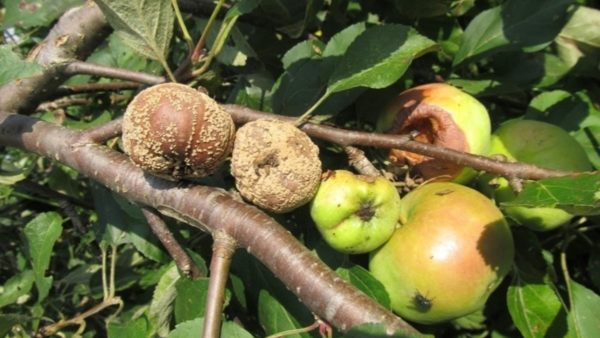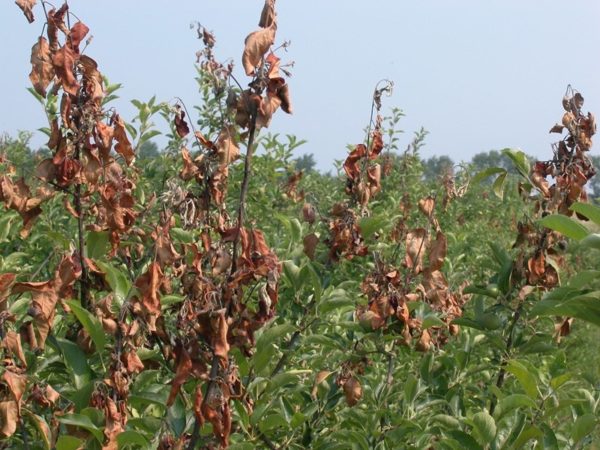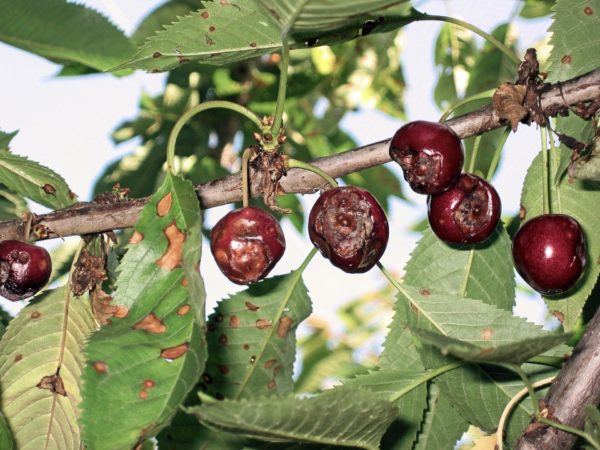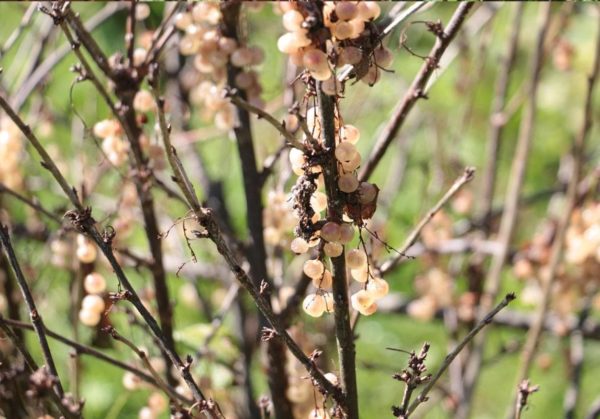A wet and prolonged spring contributes to the spread of the fungal disease moniliosis or monilial burn. The spores of this disease are carried by insects, rainwater and wind, causing infection of the fruit. Varieties less resistant to this infection, as well as fruits on poorly ventilated, infected trees with a thickened crown, suffer more.
The spread of the disease is also influenced by the abundance of wasps that pierce the skin of the fruit and they become infected with rot. Infection also occurs when rotten fruits come into contact with healthy ones.
Monilial burn of apple and pear trees
On apple and pear trees, the disease (moniliosis) manifests itself in the form of fruit rot.
Initially, a small brown spot forms on the fruit, which quickly grows and after a few days covers the entire fruit. The fruits turn brown and soften. Light yellow pads arranged in concentric circles form on the surface. The fungus develops at a temperature of 24-28 degrees and air humidity of more than 75 percent.
Fruits with moniliosis rot in 3-5 days, and sporulation appears on the 8-10th day. At high temperatures, spores may not form. The fruits become black, with a glossy tint, mummify and remain hanging on the tree, being a source of primary infection in the spring of the following year.
In a warm, rainy, prolonged spring, moniliosis on pear and apple trees can manifest itself in the form of a monilial burn. In this case, browning and drying of flowers, ovaries, fruit branches, and ringlets are observed.
The leaves turn brown and dry out, but do not fall off. Mycelium with spores develops on the affected tissue. Quince leaves have brown, almost black spots with a gray felt coating.
Methods of treatment and prevention
- In summer, it is necessary to regularly collect and remove carrion and diseased fruits.
- In the fall, collect and burn all dried, mummified fruits, and treat the trees with a 5-7% urea solution after leaf fall.
- Remove and destroy affected branches.
If moniliosis spreads, spray three times with Bordeaux mixture, chorus or ridomil.
- The first - in the phase of separation of buds by chorus - 2 g per 10 liters of water;
- The second is spraying immediately after flowering with chorus;
- Third - 10-12 days after the second spraying - with a 1% Bordeaux mixture.
The greatest effect is obtained in wet weather by treating apple trees with chorus in the first and last two days of flowering.
Monilial burn (moniliosis) of stone fruits
In sweet cherries, the disease takes the form of a monilial burn, from which entire branches with young leaves and fruit ovaries turn brown and dry out.
Primary infection occurs during the flowering period, when spores from dried overwintered fruits fall onto flowers and ovaries. Cool and wet weather promotes the spread of the disease.
Then moniliosis manifests itself in the form of rot of the fruits, which first soften, then turn brown, dry out and become covered with gray sporulation pads.
Treatment of the disease
- Treat cherries with 3% Bordeaux mixture until the buds open.
- Repeated treatment against moniliosis is carried out immediately after flowering with chorus (2-3.5 g per 10 liters of water).
- Immediately after flowering, 1% Bordeaux mixture is sprayed at the first symptoms of monilial branch burn.
- Dry branches are cut out and destroyed.
Don't forget to read:
Treatment of black currant for moniliosis
Blackcurrant also suffers from moniliosis. Affected berries lighten and become flabby. Light gray sporulation pads break through the skin. The mycelium penetrates the berries, and over time they dry out, mummify and most of them remain hanging on the branches, but some fall off.
Control measures: collection and destruction of affected berries. Treatment with 1% Bordeaux mixture or abiga-pic before flowering and after harvest.
Moniliosis of chokeberry berries
The affected berries soften, lighten, dry out, and light brown summer sporulation pads appear on their surface.
Such berries remain on the branches for a long time and overwinter on them, and in the spring, spores from the branches re-infect the flowers and young ovaries.
Treatment: removal of affected berries and branches. Spraying bushes before and after flowering with Bordeaux mixture or chorus.
Do not miss:
Sea buckthorn
Sea buckthorn berries are also affected by fruit rot. The berries first lighten and become flabby, then slimy white or ocher spore pads form on their surface. Diseased berries darken, mummify on the branches, and some fall off.
Control measures: removal of diseased berries. Treating bushes in early spring and early summer with a 1 percent Bordeaux mixture.
You might be interested:






 CUCUMBERS NEVER GET SICK, I'VE BEEN USING ONLY THIS FOR 40 YEARS! I SHARE A SECRET WITH YOU, CUCUMBERS ARE LIKE THE PICTURE!
CUCUMBERS NEVER GET SICK, I'VE BEEN USING ONLY THIS FOR 40 YEARS! I SHARE A SECRET WITH YOU, CUCUMBERS ARE LIKE THE PICTURE! You can dig a bucket of potatoes from each bush.Do you think these are fairy tales? Watch the video
You can dig a bucket of potatoes from each bush.Do you think these are fairy tales? Watch the video
 How our fellow gardeners work in Korea. There is a lot to learn and just fun to watch.
How our fellow gardeners work in Korea. There is a lot to learn and just fun to watch. Eye trainer. The author claims that with daily viewing, vision is restored. They don't charge money for views.
Eye trainer. The author claims that with daily viewing, vision is restored. They don't charge money for views. A 3-ingredient cake recipe in 30 minutes is better than Napoleon. Simple and very tasty.
A 3-ingredient cake recipe in 30 minutes is better than Napoleon. Simple and very tasty. Therapeutic exercises for cervical osteochondrosis. A complete set of exercises.
Therapeutic exercises for cervical osteochondrosis. A complete set of exercises. Which indoor plants match your zodiac sign?
Which indoor plants match your zodiac sign? What about them? Excursion to German dachas.
What about them? Excursion to German dachas.